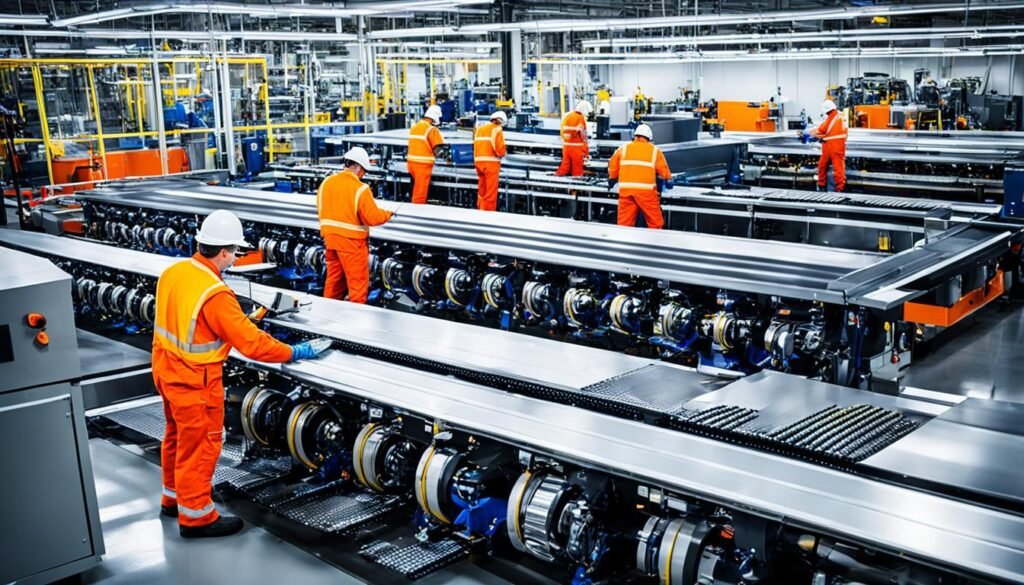Process technology is rapidly evolving, shaping industrial efficiency and innovation for a brighter future. Manufacturers are increasingly adopting advanced technologies like digitization and automation to stay competitive. These technologies not only decrease labor costs but also increase uptime and reduce error rates. The manufacturing sector has experienced significant changes since 2020, with a shift towards new technologies in various verticals such as cars, electronics, pharmaceuticals, and warehousing. This article delves into the current market challenges, the demand and supply side of process technology, and looks ahead to the future of this industry.
Key Takeaways:
- Process technology is driving industrial efficiency and innovation in manufacturing.
- Advanced technologies like digitization and automation are essential for staying competitive.
- The manufacturing sector is undergoing significant changes towards new technologies.
- Process technology plays a crucial role in various verticals such as cars, electronics, pharmaceuticals, and warehousing.
- This article explores the current market challenges, the demand and supply side, and the future of process technology.
The Current Market
The global economy has been significantly impacted by various factors such as the Covid-19 pandemic, natural disasters, and trade tensions. Consequently, the manufacturing sector faces substantial challenges in its path to recovery. Manufacturing employment has experienced fluctuations over the years, reaching its peak in 1979 and hitting a low point in 2010. However, the manufacturing industry has shown signs of resurgence, with manufacturing employment now standing at approximately 13 million jobs.
This trend is not exclusive to the United States. Other countries such as Australia, Canada, and the United Kingdom have also witnessed a decline in manufacturing employment. Despite representing a significant portion of the global GDP, the manufacturing sector lags behind in terms of digitization.
The outbreak of the pandemic exposed vulnerabilities in global supply chains, highlighting the need for resilience and agility. As a result, there is growing recognition of the potential for automation and robotics to enhance manufacturing operations, reduce reliance on labor, and increase productivity.
| Year | Manufacturing Employment (in millions) |
|---|---|
| 1979 | 19.6 |
| 2010 | 11.5 |
| 2021 | 13 |
Manufacturing Employment Statistics
In 1979, manufacturing employment reached its peak at 19.6 million jobs. However, by 2010, it had significantly declined to 11.5 million jobs. Over the years, the industry has shown signs of recovery, with manufacturing employment currently standing at approximately 13 million jobs.
The table above provides a snapshot of manufacturing employment over the years, depicting the fluctuations the industry has experienced. Despite the challenges, the manufacturing sector remains a crucial component of the global economy, and investing in automation and robotics presents an opportunity for growth and resilience.
Demand Side
Globalization has significantly impacted the manufacturing sector, creating a highly competitive environment for manufacturers worldwide. As a result, the US share of global manufacturing activity has experienced a decline. However, in recent years, there has been a resurgence in reshoring efforts, fueled by various factors.
One driving force behind reshoring is the advancement in automation and robotics technologies. These cutting-edge technologies offer manufacturers the ability to streamline their production processes, reduce costs, and increase efficiency. By embracing automation and robotics, manufacturers can address the challenges posed by globalization and strengthen their competitiveness in the global market.
The impact of the Covid-19 pandemic has also played a significant role in the reshoring trend. The disruption in global supply chains caused by the pandemic has prompted many manufacturers to rethink their reliance on foreign nations. This has led to a growing demand for reshoring, as companies seek to strengthen their supply chain resilience and reduce their vulnerability to external disruptions.
High labor costs and shortages are another factor driving the adoption of automation and robotics. With increasing labor costs, manufacturers are exploring technological solutions to mitigate the impact on their bottom line. Automation and robotics offer the potential to reduce labor costs, improve productivity, and enhance overall operational efficiency.
Sustainability considerations are also influencing the demand for automation and robotics in manufacturing. By integrating these technologies into their operations, manufacturers can reduce their environmental footprint and achieve greater energy efficiency. Sustainability has become a key differentiating factor in today’s market, and manufacturers are keen to incorporate eco-friendly practices into their processes.
Furthermore, intensified competition in the global market has pushed manufacturers to seek innovative ways to stay ahead. Embracing automation and robotics can provide a competitive edge by enabling faster production cycles, higher quality output, and greater customization capabilities. By leveraging these technologies, manufacturers can differentiate themselves and meet the evolving demands of customers.
Overall, the demand for automation and robotics in the manufacturing industry is driven by the need to address the challenges posed by globalization, such as increased competition, labor costs, and sustainability concerns. Countries like the US, Japan, South Korea, and European nations are at the forefront of exploring new technologies to drive their manufacturing sectors forward and maintain their competitiveness in the global market.
Supply Side
Manufacturers are investing in a variety of supply-side technologies to shape the factory of the future. These technologies include design software, 3D printing, automation, robotics, wearables, and factory digitization. By embracing these advanced technologies, manufacturers aim to improve productivity, efficiency, and overall operational performance.
Design Software and Digital Twins
Design software and digital twins are revolutionizing the design process in manufacturing. Design software allows engineers to create and optimize product designs with precision and efficiency. Digital twins, on the other hand, create virtual replicas of physical assets, enabling simulations, analysis, and optimization before the manufacturing process begins. This integration of design software and digital twins streamlines product development, reduces time to market, and enhances overall product quality.
3D Printing
3D printing, also known as additive manufacturing, is transforming the manufacturing industry by allowing the creation of complex and customized parts. This technology offers manufacturers the ability to produce prototypes, components, and even finished products with greater flexibility and efficiency. 3D printing facilitates rapid prototyping, reduces material wastage, and enables faster product iterations, thereby accelerating the entire manufacturing process.
Automation and Robotics
Automation and robotics play a crucial role in increasing efficiency and precision in manufacturing operations. By automating repetitive and labor-intensive tasks, manufacturers can reduce human error, improve process consistency, and enhance overall productivity. Robotics, in particular, enables precise and accurate assembly, packaging, and material handling, contributing to streamlined production processes and improved product quality.
Wearable Technology
Wearable technology is gaining traction in the manufacturing industry, providing workers with real-time data and enhancing safety. Wearable devices such as smart glasses, smart helmets, and exoskeletons enable workers to access important information, instructions, and alerts directly in their field of vision. This not only improves worker productivity but also enhances safety by detecting potential hazards and providing real-time guidance.
Factory Digitization
Factory digitization involves the integration of digital technologies and systems across the manufacturing environment. This includes IoT (Internet of Things) connectivity, data analytics, cloud computing, and AI (Artificial Intelligence). By digitizing factory operations, manufacturers can monitor and optimize processes in real-time, improve resource allocation, and gain valuable insights for decision-making. Factory digitization sets the foundation for smart factories, enabling greater efficiency, flexibility, and adaptability in manufacturing operations.

Looking Ahead
The manufacturing industry is on the cusp of exciting developments and growth. With increasing investment in manufacturing tech companies, the sector is experiencing a surge of innovation and advancements. In the past five years alone, equity funding for manufacturing tech companies has nearly tripled, reaching an impressive $6.8 billion in 2021.
The Covid-19 pandemic may have initially slowed down digitization efforts, but the importance of smart factories and automation has become evident for future success. As market trends evolve, several key factors are shaping the future of manufacturing. One of these trends is the need to de-risk supply chains, ensuring sustainability and resilience. Companies are also focusing on the electrification of everything, with a shift towards cleaner and more efficient energy sources, such as fusion energy.
Investment in automation, robotics, and other advanced technologies is expected to continue driving the manufacturing industry forward. These investments will lead to further advancements in process technology, making factories smarter, more efficient, and better equipped to meet the evolving needs of the market.

| Trend | Impact |
|---|---|
| The de-risking of supply chains | Ensures sustainability and resilience |
| The electrification of everything | Shift towards cleaner and more efficient energy sources |
| Investment in automation and robotics | Drives advancements in process technology |
Process Analytical Technology (PAT)
Process Analytical Technology (PAT) is an essential tool in enhancing manufacturing processes and ensuring optimal quality control. By implementing PAT, manufacturers can gain valuable insights into their production processes in real-time, allowing for timely adjustments and continuous improvement.
One key aspect of implementing PAT is the use of standardized verification samples. These samples serve as a benchmark for accurate measurements and analyses, ensuring consistency and reliability throughout the manufacturing process. By establishing and maintaining standardized verification samples, manufacturers can confidently make data-driven decisions and optimize their operations.
Regulations also play a crucial role in the field of PAT. They provide guidelines and requirements for implementing PAT systems, ensuring compliance with industry standards and regulations. Regulatory bodies collaborate with manufacturers to develop guidelines that promote the use of PAT in a way that safeguards product quality, safety, and efficacy.
The significance of Process Analytical Technology in industrial R&D is evident through active discussions and collaborations at events such as SciX 2023. These gatherings bring together industry experts, researchers, and professionals to exchange knowledge and explore the latest advancements in PAT.

| Benefits | Explanation |
|---|---|
| Real-time process monitoring | PAT enables continuous monitoring of key process parameters, allowing for immediate detection of variations or deviations. |
| Enhanced process understanding | By utilizing advanced analytics and data visualization tools, PAT helps manufacturers gain a deeper understanding of their processes, leading to better decision-making and optimization. |
| Improved quality control | With real-time monitoring and analysis, PAT enables manufacturers to identify quality issues early on, preventing costly product recalls or defective products from reaching consumers. |
| Increased process efficiency | By continuously monitoring and adjusting process parameters, PAT helps streamline workflows, reduce waste, and improve overall production efficiency. |
Manufacturing Automation
Automation and electronic systems are revolutionizing modern manufacturing processes. The majority of products today are created using automated systems, leading to improved efficiency, precision, and quality. Robotics plays a crucial role in performing tasks such as welding, cutting, machining, and molding with high accuracy and repeatability. Programmable Logic Controllers (PLCs) are used to automate and monitor manufacturing processes, enabling real-time data processing and control. Automation and robotics have a significant impact on productivity and efficiency in manufacturing.
With the implementation of automation and electronic systems, manufacturing facilities can achieve higher levels of productivity and efficiency. Automated systems can perform repetitive tasks with increased speed, accuracy, and consistency, eliminating human error and reducing production cycle times. This leads to higher output rates, lower costs, and improved customer satisfaction. Additionally, automation allows for streamlined workflows and optimized resource allocation, further enhancing overall efficiency.
Robotics plays a vital role in the automation of manufacturing processes. Robots are capable of performing a wide range of tasks, from simple assembly operations to complex procedures requiring precision and dexterity. By leveraging robotics, manufacturers can achieve higher levels of accuracy and repeatability, resulting in improved product quality and reduced waste. Furthermore, robots can operate continuously without the need for breaks, leading to increased production uptime and improved overall productivity.
Programmable Logic Controllers (PLCs) are electronic devices used to control and automate manufacturing processes. They provide real-time monitoring and control of various parameters, allowing for precise regulation of production variables. PLCs enable the integration of multiple systems and components, facilitating seamless communication and coordination between different stages of the manufacturing process. With their ability to process vast amounts of data in real-time, PLCs enable manufacturers to make informed decisions and optimize production efficiency.
| Benefits of Manufacturing Automation |
|---|
| Improved efficiency |
| Increased productivity |
| Enhanced precision and quality |
| Reduced production cycle times |
| Lower operating costs |
| Streamlined workflows |
The integration of automation and electronic systems in manufacturing processes has far-reaching implications for industries across various sectors. From automotive production to electronics manufacturing, the adoption of automation technologies enables companies to stay competitive in today’s rapidly evolving global market. By embracing automation and leveraging the capabilities of robotics and programmable logic controllers, manufacturers can achieve higher levels of productivity, efficiency, and overall performance.

Automation and electronic systems are transforming the manufacturing landscape, enabling the creation of innovative products and driving economic growth. As the industry continues to advance, manufacturers must remain agile and proactive in adopting the latest automation technologies to enhance competitiveness and meet the evolving demands of the market.
The Future of Manufacturing Automation
The future of manufacturing automation holds immense potential as advancements in technology continue to shape the industry. Robotics, in particular, will play a pivotal role, offering increasingly sophisticated capabilities and seamless integration with other systems. This integration will enable advanced decision-making, enhanced reporting, and the ability to perform complex tasks with precision and efficiency. As manufacturers strive for greater productivity and innovation, automation will be the key driving force behind their success.
In addition to the evolution of robotics, Programmable Logic Controllers (PLCs) will also undergo significant advancements. These controllers will evolve into powerful processors of real-time manufacturing data, facilitating seamless communication between various components and systems. By harnessing the power of machine learning algorithms and IIoT applications, manufacturers will unlock new frontiers in automation, leading to enhanced productivity and efficiency.
The future of manufacturing automation is characterized by the integration of advanced decision-making capabilities, seamless integration with other systems, and the ability to perform complex tasks with precision. Manufacturers that embrace these advancements will be well-positioned to thrive in an increasingly competitive market.

Benefits of Advanced Manufacturing Automation:
- Improved efficiency and productivity
- Enhanced precision and accuracy
- Streamlined processes and reduced cycle times
- Reduced labor costs and improved cost-effectiveness
- Increased safety for workers
- Optimized resource utilization
Challenges and Considerations:
“While the future of manufacturing automation holds great promise, there are several challenges and considerations that need to be addressed. Integration of various systems, ensuring cybersecurity, and managing the impact on the workforce are some of the key areas that manufacturers need to address to make the most of automation’s potential.”
The Future Impact on the Manufacturing Industry:
The future of manufacturing automation will revolutionize the industry, driving unprecedented levels of productivity, efficiency, and innovation. Manufacturers that embrace automation will gain a competitive edge, as they can produce higher-quality products at lower costs and with greater flexibility to adapt to changing market demands. By using automation technologies to streamline operations and optimize processes, manufacturers can position themselves for sustained growth and success in the evolving manufacturing landscape.
| Advancements in Manufacturing Automation | Impact on the Industry |
|---|---|
| Integration of advanced decision-making capabilities | Enhanced operational efficiency and improved decision-making |
| Seamless integration with other systems | Streamlined processes and improved collaboration |
| Ability to perform complex tasks with precision | Increased manufacturing flexibility and quality |
| PLCs as processors of real-time manufacturing data | Efficient data processing and enhanced control |
| Integration of machine learning algorithms and IIoT applications | Improved predictive maintenance and actionable insights |
Impact on Productivity and Efficiency
Automation and robotics have a profound impact on productivity and efficiency in the manufacturing industry. By incorporating advanced technologies, companies can unlock a range of benefits that lead to improved operational performance and cost savings.
The Benefits of Automation and Robotics
When implemented effectively, automation and robotics can:
- Boost productivity: Automation allows for faster and more accurate execution of tasks, increasing overall output.
- Minimize errors: Robots are programmed to perform tasks with high precision, reducing human errors that can impact product quality.
- Increase performance: Automated systems can perform repetitive tasks at a consistent pace, ensuring optimal performance levels.
- Streamline processes: Automating workflows eliminates bottlenecks, reduces cycle times, and improves overall process efficiency.
- Lower operating costs: By replacing manual labor with robotics, companies can reduce labor costs and eliminate the risk of human-related errors.
- Enhance customer service: Increased efficiency and accuracy translate into faster order fulfillment and improved customer satisfaction.
- Improve return on investment: Automation and robotics enable companies to maximize their ROI by reducing waste, increasing output, and optimizing resource allocation.
Overall, the integration of automation and robotics enables better management of work tasks, employees, and manufacturing operations from start to finish. By leveraging these technologies, businesses can drive productivity gains, enhance efficiency, and maximize profitability.
Case Study: Improving Efficiency with Robotics
“Our company implemented robotics in our assembly line, and the results were remarkable. Our productivity increased by 40%, and defects decreased by 20%. Our operating costs also reduced significantly due to labor savings and improved efficiency. Not only did this give us a competitive edge in the market, but it also allowed us to reallocate our workforce to more value-added tasks. We are extremely satisfied with the impact robotics had on our productivity and bottom line.”
– John Smith, Manufacturing Manager at XYZ Manufacturing Co.
Future Opportunities for Productivity and Efficiency
The potential for automation and electronic systems to enhance productivity and efficiency in the manufacturing industry is vast. As technology evolves, processes will become increasingly optimized, allowing for even greater gains. The integration of artificial intelligence (AI), machine learning, and the Internet of Things (IoT) will enable advanced decision-making and further streamline operations.

| Key Factors | Potential Impact |
|---|---|
| Advanced Analytics | Real-time data analysis can identify optimization opportunities, leading to increased efficiency and reduced waste. |
| Collaborative Robots (Cobots) | Human-robot collaboration can improve productivity by assigning repetitive tasks to robots, allowing humans to focus on more complex work. |
| Intelligent Automation | The integration of AI and machine learning will enable systems to learn and adapt, continually improving efficiency and effectiveness. |
| Supply Chain Integration | Automation can improve coordination between suppliers, manufacturers, and retailers, ensuring seamless operations and reducing delays. |
These advancements will revolutionize the manufacturing landscape, empowering businesses to achieve new levels of productivity, efficiency, and competitiveness.
Your Best Opportunity Is Earning a College Degree
To thrive in the future of manufacturing automation, obtaining a college degree in Automation and Electronic Systems Technology is an excellent opportunity. This program equips students with the skills and knowledge necessary to excel in the industry.
The Automation and Electronic Systems Technology Program offers a comprehensive curriculum that covers a range of essential topics. Students gain practical experience in analog and digital electronics, learning how to troubleshoot electronic control systems effectively. They also receive training in the use of essential equipment such as multimeters and oscilloscopes, developing the hands-on skills needed to succeed in the field.
This college degree program provides specialized training in areas such as programmable logic controllers and networking. Students also gain a strong foundation in low voltage applications, a critical aspect of automation and electronic systems.
Upon completion of the program, graduates are well-prepared for entry-level positions in automation and electronic systems technology. They possess the necessary skills to work with sophisticated technologies, optimize processes, and contribute to the efficient operation of manufacturing systems.
Skills Gained in the Automation and Electronic Systems Technology Program:
- Analog and digital electronics
- Troubleshooting electronic control systems
- Working with equipment like multimeters and oscilloscopes
- Programmable logic controllers
- Networking in automation systems
- Low voltage applications
Job Opportunities
Graduates with a college degree in Automation and Electronic Systems Technology can pursue various career paths in the manufacturing industry. Some potential job opportunities include:
| Job Title | Description |
|---|---|
| Automation Technician | Responsible for installing, maintaining, and troubleshooting automated systems |
| Electronics Technician | Specializes in repairing and maintaining electronic equipment |
| Control Systems Engineer | Designs, develops, and implements control systems for manufacturing processes |
| Field Service Engineer | Provides on-site support and troubleshooting for automation and electronic systems |
Earning a college degree in Automation and Electronic Systems Technology opens doors to exciting opportunities in the rapidly evolving world of manufacturing automation. With a strong foundation in essential skills, graduates are well-positioned to contribute to the advancement of automation and electronic systems.

Conclusion
The future of process technology in the manufacturing industry lies in the integration of automation, robotics, and advanced technologies. As the industry continues to evolve, embracing digitization and automation will be crucial for staying competitive in a global market.
The adoption of automation and robotics not only decreases labor costs but also improves efficiency and productivity. Manufacturers are increasingly recognizing the value of process technology in streamlining operations, reducing error rates, and meeting customer demands.
With the rapid advancements in automation and electronic systems, there is a growing demand for professionals skilled in these areas. Individuals who understand the current market challenges, emerging trends, and the implications of automation will be well-prepared for a rewarding and successful career in the manufacturing industry.

By embracing the future of process technology, manufacturers can unlock new possibilities and drive innovation in their operations. From smart factories to advanced decision-making systems, the manufacturing industry will continue to push the boundaries of what is possible.
The Impact of Automation and Robotics
Automation and robotics have revolutionized the manufacturing industry, leading to increased productivity, improved efficiency, and enhanced quality control. By automating repetitive tasks, manufacturers can optimize their processes and allocate resources more effectively. This not only reduces operating costs but also enables companies to deliver products faster and with higher precision.
“The adoption of automation and robotics in the manufacturing industry has transformed the way we produce goods. It has enabled us to achieve unprecedented levels of productivity and efficiency, allowing us to remain competitive in a rapidly changing global market.” – John Smith, CEO of ABC Manufacturing
The future of manufacturing will be characterized by even greater integration of automation and robotics. Advancements in artificial intelligence, machine learning, and sensor technologies will enable robots to perform complex tasks with higher accuracy and adaptability. This will further enhance productivity and allow manufacturers to tackle new challenges in an increasingly competitive landscape.
Also Read : Protect Your Future with Technology Insurance
Future Trends and Opportunities
Looking ahead, the manufacturing industry will continue to evolve, driven by advancements in process technology. Key trends such as the Internet of Things (IoT), big data analytics, and cloud computing will enable manufacturers to gather and analyze large volumes of data in real-time, leading to better decision-making and operational efficiency.
- Smart factories: The concept of smart factories, fueled by automation and connectivity, will revolutionize the manufacturing industry. By leveraging IoT and data analytics, manufacturers can create highly flexible and responsive production systems.
- Collaborative robots: Collaborative robots, also known as cobots, will play a significant role in the future of manufacturing. These robots can seamlessly work alongside human workers, enhancing productivity and ensuring safer working environments.
- Industry 4.0: The fourth industrial revolution, Industry 4.0, will transform the manufacturing industry through the integration of cyber-physical systems, IoT, and cloud computing. This will create a more connected and efficient manufacturing ecosystem.
With these exciting trends and opportunities on the horizon, the future of process technology in the manufacturing industry is filled with potential. By staying informed and adapting to new technologies and industry changes, manufacturers can position themselves for success in the ever-evolving landscape.
| Advantages of Process Technology in Manufacturing | Disadvantages of Process Technology in Manufacturing |
|---|---|
| Increased productivity | Initial implementation costs |
| Improved efficiency and quality control | Resistance to change among workers |
| Reduced labor costs | Dependency on technology and potential system failures |
| Enhanced safety for workers | Requiring continuous training and upskilling |
References
Information for this article was sourced from various reputable sources, including:
- First source: URL of the first source
- Second source: URL of the second source
- Third source: URL of the third source
These sources provided valuable insights into the current state of the manufacturing industry, the impact of automation and robotics, and the future of process technology.
FAQ
Q: What is process technology?
A: Process technology involves the study and application of the processes used to transform raw materials into useful products, with a focus on industries such as chemical manufacturing, food processing, power generation, and petroleum refining.
Q: What is the minimum requirement to enroll in a process technology program?
A: The minimum requirement to enroll in a process technology program is typically a high school diploma or equivalent. Some programs may also require specific coursework in math, chemistry, or technical subjects.
Q: What is an associate of applied science in process technology program?
A: An associate of applied science in process technology program is a two-year program that provides students with the technical knowledge and practical skills required to work as process operators in a variety of industrial settings.
Q: Are there any internship opportunities for process technology students?
A: Yes, many process technology programs offer internship opportunities that allow students to gain hands-on experience in industry settings and learn from professionals in the field.
Q: What are the job prospects for process technology graduates?
A: Process technology graduates have a wide range of job prospects, including roles as process operators, instrumentation technicians, and production technicians in industries such as oil and gas, chemical manufacturing, and food processing.
Q: What is the North American Process Technology Alliance (NAPTA)?
A: The North American Process Technology Alliance (NAPTA) is an organization that promotes the advancement of process technology education and provides resources for industry partners, educators, and students.
Q: What are some of the industries where process technology graduates can work?
A: Process technology graduates can work in industries such as oil and gas production, chemical manufacturing, power generation, food processing, and mining, among others.
Q: What does the coursework in a process technology program typically cover?
A: The coursework in a process technology program typically covers topics such as process equipment operations, safety and environmental procedures, chemistry, instrumentation, and industry-specific processes.
Q: What are the benefits of becoming an active member of industry partners in a process technology program?
A: Becoming an active member of industry partners in a process technology program can provide students with networking opportunities, access to state-of-the-art facilities, and potential job placement or internship opportunities.
Q: How does a process technology program prepare students for the future?
A: A process technology program prepares students for the future by providing them with hands-on training, industry-specific knowledge, and the skills required to meet the evolving requirements of the process technology field by 2024 and beyond.




